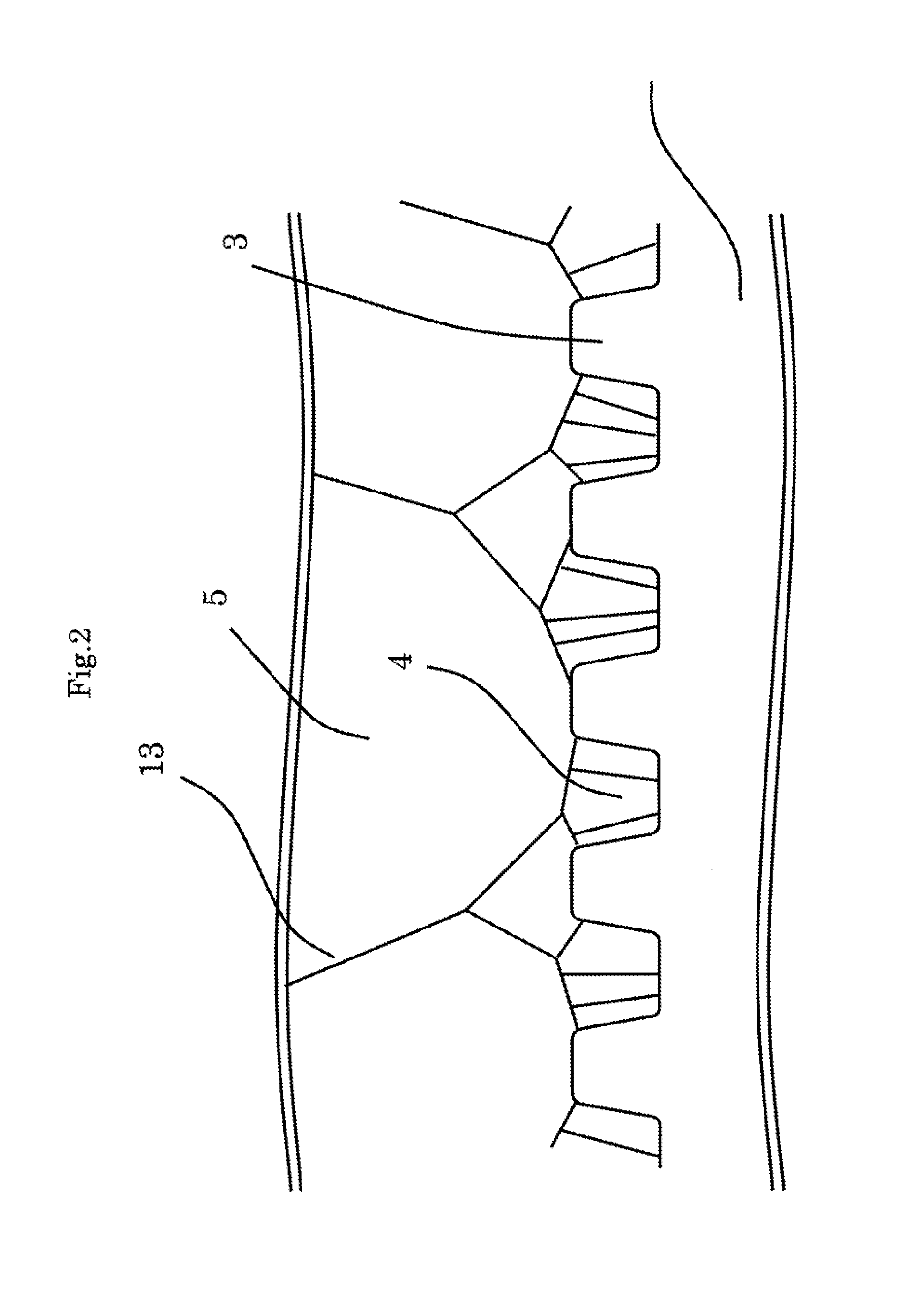Composite Substrates, Light Emitting Devices and a Method of Producing Composite Substrates
a technology of composite substrates and light emitting devices, which is applied in the direction of polycrystalline material growth, crystal growth process, chemically reactive gas, etc., can solve the problems of cracks or fractures in the gan layer of the gan template, and achieve the effect of small warping amoun
- Summary
- Abstract
- Description
- Claims
- Application Information
AI Technical Summary
Benefits of technology
Problems solved by technology
Method used
Image
Examples
example 1
Processing of Sapphire Body
[0069]A resist having a thickness of 1 μm was patterned on a surface of a c-face sapphire body having a diameter of 2 inches and a thickness of 500 μm using photolithography. As to the resist pattern, the pattern was designed so that the hexagonal prisms, each having a diagonal line width “E” of 4 μm, were arranged at a period “D” of 6 μm so as to be six-fold rotational symmetrical. This was subjected to etching for 10 minutes using a chlorine-based dry etching system to etch the sapphire body to a depth of about 1.5 μm where it is not covered by the resist, to leave protrusions each having a shape of hexagonal prism where the resist was present. The residue of the resist was removed by a remover.
[0070]It was thereby obtained a sapphire body 2A as shown in FIG. 6. That is, a plurality of protrusions 3A were formed on a c-face 2a of the sapphire body 2A. Each of the protrusions 3A has a shape of a hexagonal prism, and the protrusions 3A were positioned so a...
example 2
[0088]A c-face sapphire body having a diameter of 2 inches was etched by applying chlorine based dry etching in a depth of about 2 μm according to the same procedure as the Example 1, except that a thickness of the resist was made 0.5 μm, so that the shape of each protrusion was proved to be six-sided pyramid.
[0089]The sapphire body after the processing of the protrusions and recesses was used to form the underlying layer according to the same procedure as the Example 1. The warping was about 20 μm, and it was observed spaces, each having a size of 1 μm to several μm, between the protrusions. Thereafter, a GaN composite substrate was produced and films for an LED structure were then formed, according to the same procedure as the Example 1.
[0090]The substrate was taken out of the MOCVD furnace and then observed by eyes to prove that cracks were not observed. Further, it was observed by a differential interference contrast microscope to prove that the surface was flat.
[0091]The wafer ...
example 3
[0092]A c-face sapphire body having a diameter of 2 inches was etched by applying chlorine based dry etching in a depth of about 2 μm according to the same procedure as the Example 1, except that the period of the protrusions “D” was made 6 μm and the diagonal line width “E” of the hexagon was made 3 μm, so that the shape of each protrusion was proved to be hexagonal prism.
[0093]The sapphire body after the processing of the protrusions and recesses was used to form the underlying layer according to the same procedure as the Example 1. The warping was about 25 μm, and it was observed spaces, each having a size of 1 μm to several μm, between the protrusions. Thereafter, a GaN composite substrate was produced and films for an LED structure were then formed, according to the same procedure as the Example 1.
[0094]The substrate was taken out of the MOCVD furnace and then observed by eyes to prove that cracks were not observed. Further, it was observed by a differential interference contra...
PUM
| Property | Measurement | Unit |
|---|---|---|
| thickness | aaaaa | aaaaa |
| width | aaaaa | aaaaa |
| width | aaaaa | aaaaa |
Abstract
Description
Claims
Application Information
 Login to View More
Login to View More - R&D
- Intellectual Property
- Life Sciences
- Materials
- Tech Scout
- Unparalleled Data Quality
- Higher Quality Content
- 60% Fewer Hallucinations
Browse by: Latest US Patents, China's latest patents, Technical Efficacy Thesaurus, Application Domain, Technology Topic, Popular Technical Reports.
© 2025 PatSnap. All rights reserved.Legal|Privacy policy|Modern Slavery Act Transparency Statement|Sitemap|About US| Contact US: help@patsnap.com



